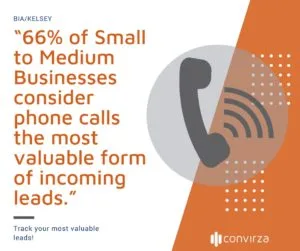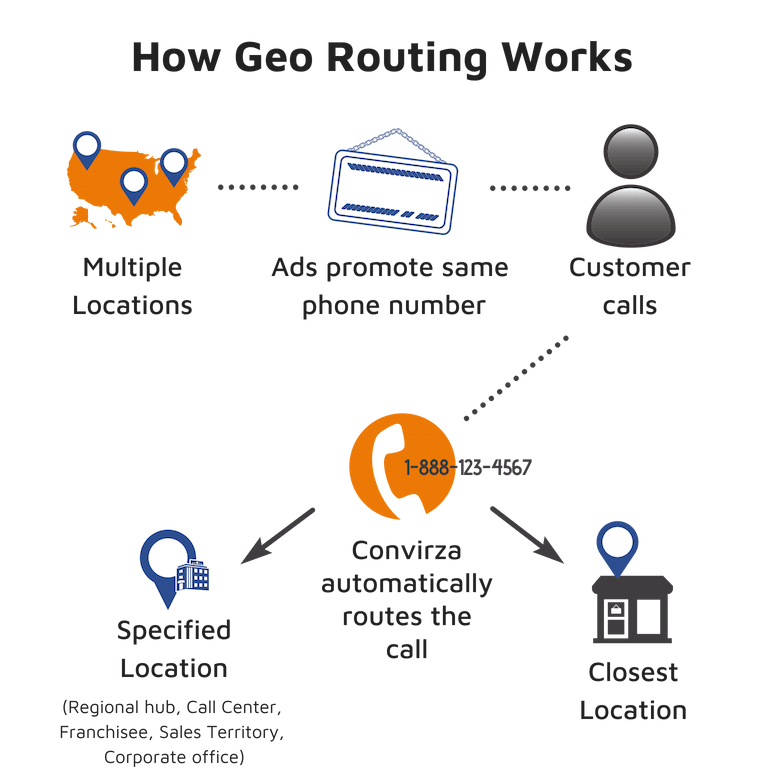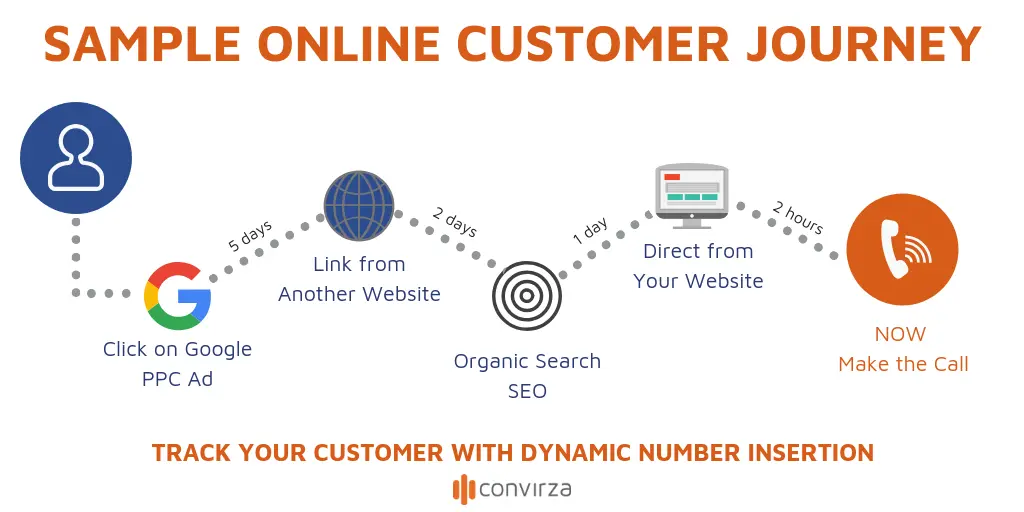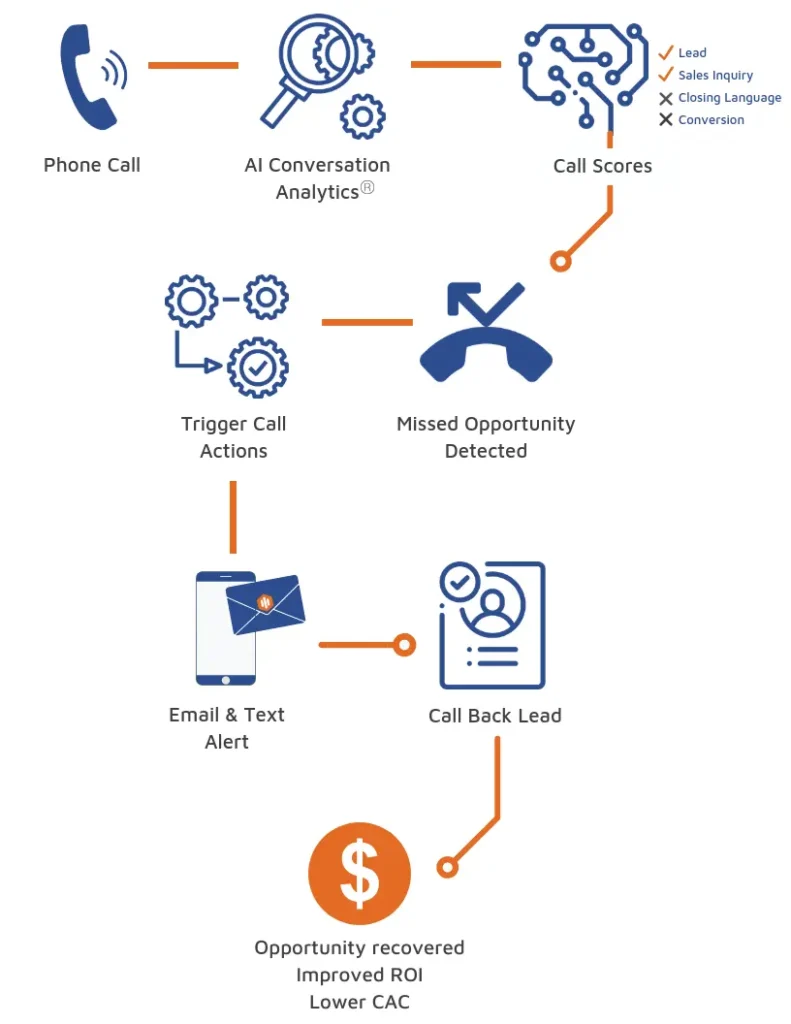
Phone calls still matter and are very important to millions of businesses.

Lets dive into three stages of call statistics and tracking metrics:
One of the primary uses of call tracking is to determine which ads work and which one do not. Marketers attach unique tracking numbers, marketers to various touch points. When someone calls the phone number,
Convirza knows what influenced the call.
Every phone call is connected with a campaign and can be viewed and listened to on the Marketing Dashboard and in the Call Logs dashboard.
Call tracking metrics clearly show which marketing channels and ads generate new leads and business. You can concentrate on the ads that work and either ditch the non-working ads or adjust the ad. This type of data saves marketers money and ensure that their efforts are producing results.
Metrics to measure
If you are using PPC and other ads to run a campaign then our suggestion is to use a different number with ad and establish which one works better. In essence this is A/B testing for ads. The ad that triggers the most phone calls and the best leads is the winner.
The more accurately your ad copy is aligned to the keywords search the easier it is to trigger an action from a user.
For example–
When a user searches for ‘Toyota car dealers’, they are more likely to click on ads that have the keyword ‘Toyota’ in them. If your ad is too generic, you’ll probably lose the click to your competition.
For paid search and SEO, Google Analytics is the first source for data . But You will understand by the end of this analysis which ads and keywords are your leading horses and bet accordingly.
This indicator is purely a quantity metric. This does not in any way indicate the quality of the caller.
Unless you follow through with analyzing the following metrics you may still be playing a losing game.
A/B testing is highly recommended for businesses trying to establish a new way to generate more leads through telephonic ad campaigns.
Metrics to measure
Talking to someone you know is so much easier than building a new connection altogether.
Profiling is not just a post-call activity (more at the bottom) but a pre-call activity too.
With call tracking softwares you can see the exact location of a user when they call you.
This helps your executive ease the customer into a casual conversation or decide the probability of the customer walking into your store post a call.
For example, a person from Canada looking for winter gear is more likely to buy a warm jacket than someone who is closer to the equator.
Your executive has a chance at customizing the script even before the call has started.
More information about the client can act as a confidence booster for your team and help them sound confident about the pitch.

Metrics to measure
When you are using multiple mediums to communicate with the same person it’s easy to lose track of what you promised them to begin with.
The landing page is the last visual point of reference for a calling customer. If your calling executive deviates from the deal offered you can assume the customer is lost, unless the deal is better than the original one.
Match the calling script to adhere to the customer journey that you had in mind.
What you can measure here is the difference in the script and the brand promise causing you to lose customers.
Wondering who can help you keep track?
Well, a person certainly cannot but DNI or Dynamic Number Insertion can. A part of call tracking metrics is measuring how each ad campaign is performing. It tracks the ad a person clicks to reach your calling executive. Giving your staff an opportunity to align the pitch to the language used in the ad.

If you are unsure how to use Dynamic Number Insertion, make sure you read this blog, Call Tracking and SEO: Trick or Treat? Also, download the free whitepaper, The Authoritative Guide to Local SEO Call Tracking, for precise instructions and JavaScript code.
Bonus Tip- One way to solve this problem and a crucial aspect that we marketers forget is to share the ad copy or a link to the landing page with our hardworking calling staff.
They need to know what led the caller to them and be consistent with the language of the advertisement.
Metrics to measure
I hate those endless IVR journeys.
Where at the end you talk to an executive who’s probably going to ask you the same things anyway.
It completely ruins a brand image for me, especially regarding customer service. I would consider switching for such basic reasons too.
Check how many buttons a customer had to press to get to you and map it to the emotional state they are in during the call through advanced analytics.
If the IVR is not helping you cut down on the questions then consider removing it from a callers experience.
What happens before a call will have an impact on how the call goes.
Nobody wants to start a call with an irate customer.
With global call center staff attrition rate at 15 %, you want to save your team’s morale and increase conversions to help them feel like a success. (Source)
When the conversation begins, it’s time to listen in and also to look at the numbers. Real time optimization has taken a momentum of its own. Look at these statistics to capitalize on each call.
Metrics to measure
A repeat caller being treated like a new caller is possibly one of the most frustrating experiences a customer can have.
A repeat caller is a qualified lead and hence should be treated like one.
Asking them to re-qualify themselves takes away precious time that can be spent on closing that deal instead.
The difference between these two conversations is crucial to finalizing a sale with a repeat caller-
Hi, this is Matthew from XYZ. How may I help you today?
Vs.
Hey Matthew, we see that you called us 2 days ago regarding product abc. How can I help you take this forward?
Measuring or tracking this call metric should help you establish the number of calls it takes to convert a caller into a happy customer.
Also, remember to peek into how many of the repeat callers are calling for customer care or finishing a purchase. This should tell you if all repeat callers should directly be mapped to the customer support team or not.
Metrics to measure
Notice how some executives have a higher conversion rate than others?
They really know the art of conversation and make a person feel comfortable enough to close a deal.
With conversation analytics, you can identify what language or word combinations actually helped a person feel comfortable enough to give you their hard earned money without even meeting you.
Similarly, every person has a reason for declining an offer, it could be the offer itself or the executive they were connected with. If the reason is often repeated then it needs to be addressed.
If customers keep dropping off for reasons like lack of clarity in the speech or gaps in the executive’s explanation then it needs to be addressed with urgency.
Look at tools with built-in missed opportunity alerts.
A bad call can consist of signals that even we humans may miss out due to the iterative nature of our jobs.
Recently, I pulled out a call that made me realize that I was overlooking the pauses that made a difference in the tone of our customers.
Executive A- Hi Mike, uuuhhh could I ask you to hold on for a few seconds while I look up this information?
Mike- Sure
After a minute or so
Executive A- Hey, uuhhh so I found the information, could you hold on while I go through it.
Mike- Ok, but don’t put me on hold this time.
Executive A takes another minute to tell Mike details that should be at hand the moment a repeat customer calls. Mike has already lost patience after waiting for a minute. The executive should be alert enough to make sure that he doesn’t keep Mike waiting.
With call tracking software, you will know if this was a one-off case or it is a case of poorly trained executives. Here’s how missed opportunity works at Convirza.

The flip side to this is the conversations that win. Identify phrases that made a customer delighted and helped your brand gain a loyal customer.
Metrics to measure
The global average for a call duration is 4 minutes. (Source)
For your industry, it may differ but the duration of a call speaks a lot.
If it is too long, it could be that the customer has a lot of objections that need to be overcome or that your staff needs to be trained harder at overcoming objections.
Very brief calls can also indicate unqualified leads being led to your calling team.
Identifying the best call duration for your call center can help you optimize your campaign for better informed and qualified leads.
Post-call tracking metrics is what will shine the light on the path to take with your marketing efforts. These statistics can guide you in company projections, skill development and future planning.
Metrics to measure
Knowing what faction of society is responding the best to your campaigns can ease the pain of identifying concrete targets immensely.
When your executive is on the phone, work a way to validate this information without the customer feeling like it’s a data accumulation process.
These data points are as important as the real conversions because customization is key today.
Starting a call with questions like-
“Is this your phone number?” or “Is this your current address?”
Go for validations after there is a basic level of engagement with them-
“Dave, I hope you have the answers you were looking for. Can I take a minute to confirm your details with us?”
And then go on to fill in those fields.
This suggestion is perhaps not for everyone. But just like a warm-up helps you stretch better, a build up should help you get more information from a customer.
Luckily demographics like location, age, gender, interests are also how digital platforms help you target your potential customer. Ergo, knowing each callers’ demographics has a direct impact on your ad planning and spends.
Metrics to measure
Wednesdays and Thursdays between 4 to 5 pm is the best time to contact a lead if you want to have a chance at qualifying them. (Source)
However, with inbound calls, most people assume that you do not have as much control.
This is not entirely true.
Your callers are most likely to call you when they see your ad and at what time they see your ad is in your control, with the digital mediums at least.
You can actually choose a time slot during which most of your target market will see your ad.
The ideal time will vary depending on your customers’ occupation.
Suppose, your target market is stay-at-home moms, then the above statistic probably doesn’t apply.
Working moms would have more time to engage with you when their kids and husband are away at school or work. So, before lunchtime is probably the best shot you have at catching them in a relaxed state.
When you are measuring this metric remember that you can affect it.
Metrics to measure
It is without a doubt the highlight of the day when a sale is closed.
Once you have given a thumbs up to your team it’s time for a little more work. And this extra effort is what will help you gauge the importance of your calling team in your revenue sheet.
Deep diving into a successful sale is probably as important, if not more than studying a failed attempt.
You can identify up-selling or cross-selling opportunities with a customer who is warm to you already.
You cannot establish the true cost of an ad or a call until you have identified and served all possible needs of your customers that your company can fulfill.
Metrics to measure
We all have quality assessors in our team. But can they listen to every single call ever made by every executive?
Not unless you have an assessor dedicated to every caller.
Here’s where Artificial Intelligence is that much-revered technological development.
With advanced call analytics, you can actually measure how good or bad your employees’ skills are with every single call.
Their abilities, weak or strong, can be highlighted to make sure that each individual gets customized training and attention with Convirza’s Conversation Analytics®. Here’s a video that explains how Conversation Analytics® works:
There are 4000 + factors that help our clients formulate a victorious ad campaign. Our job is to make sure that each factor is given its due attention.
And each business should have a chance at making it big with call tracking at their service.
If you would like to get started for free, you can have a no-risk 21 Day free trial.

Book A Quick 15 Minute Call,
And We’ll Show You How To Unlock The Power Of Every Conversation.
©2024 All rights reserved – Convirza